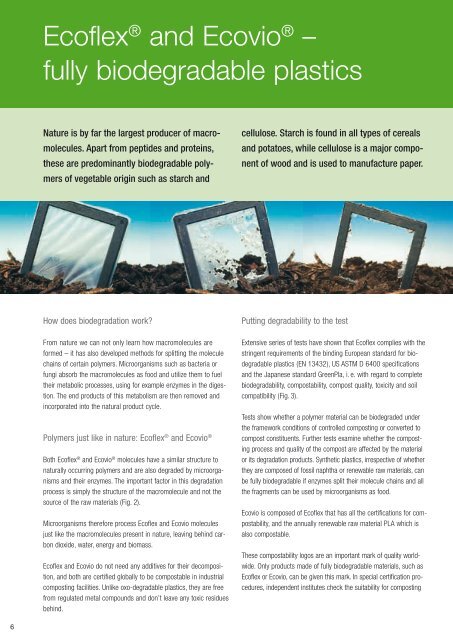Ecoflex Ecovio – Biopolymers – Inspired by nature – Broschüre
Ecoflex Ecovio – Biopolymers – Inspired by nature – Broschüre
Ecoflex Ecovio – Biopolymers – Inspired by nature – Broschüre
Create successful ePaper yourself
Turn your PDF publications into a flip-book with our unique Google optimized e-Paper software.
6<br />
<strong>Ecoflex</strong> ® and <strong>Ecovio</strong> ® <strong>–</strong><br />
fully biodegradable plastics<br />
Nature is <strong>by</strong> far the largest producer of macromolecules.<br />
Apart from peptides and proteins,<br />
these are predominantly biodegradable polymers<br />
of vegetable origin such as starch and<br />
How does biodegradation work?<br />
From <strong>nature</strong> we can not only learn how macromolecules are<br />
formed <strong>–</strong> it has also developed methods for splitting the molecule<br />
chains of certain polymers. Microorganisms such as bacteria or<br />
fungi absorb the macromolecules as food and utilize them to fuel<br />
their metabolic processes, using for example enzymes in the digestion.<br />
The end products of this metabolism are then removed and<br />
incorporated into the natural product cycle.<br />
Polymers just like in <strong>nature</strong>: <strong>Ecoflex</strong> ® and <strong>Ecovio</strong> ®<br />
Both <strong>Ecoflex</strong> ® and <strong>Ecovio</strong> ® molecules have a similar structure to<br />
naturally occurring polymers and are also degraded <strong>by</strong> microorganisms<br />
and their enzymes. The important factor in this degradation<br />
process is simply the structure of the macromolecule and not the<br />
source of the raw materials ( Fig. 2).<br />
Microorganisms therefore process <strong>Ecoflex</strong> and <strong>Ecovio</strong> molecules<br />
just like the macromolecules present in <strong>nature</strong>, leaving behind carbon<br />
dioxide, water, energy and biomass.<br />
<strong>Ecoflex</strong> and <strong>Ecovio</strong> do not need any additives for their decomposition,<br />
and both are certified globally to be compostable in industrial<br />
composting facilities. Unlike oxo-degradable plastics, they are free<br />
from regulated metal compounds and don’t leave any toxic residues<br />
behind.<br />
cellulose. Starch is found in all types of cereals<br />
and potatoes, while cellulose is a major component<br />
of wood and is used to manufacture paper.<br />
Putting degradability to the test<br />
Extensive series of tests have shown that <strong>Ecoflex</strong> complies with the<br />
stringent requirements of the binding European standard for biodegradable<br />
plastics ( EN 13432 ), US ASTM D 6400 specifications<br />
and the Japanese standard GreenPla, i. e. with regard to complete<br />
biodegradability, compostability, compost quality, toxicity and soil<br />
compatibility ( Fig. 3).<br />
Tests show whether a polymer material can be biodegraded under<br />
the framework conditions of controlled composting or converted to<br />
compost constituents. Further tests examine whether the composting<br />
process and quality of the compost are affected <strong>by</strong> the material<br />
or its degradation products. Synthetic plastics, irrespective of whether<br />
they are composed of fossil naphtha or renewable raw materials, can<br />
be fully biodegradable if enzymes split their molecule chains and all<br />
the fragments can be used <strong>by</strong> microorganisms as food.<br />
<strong>Ecovio</strong> is composed of <strong>Ecoflex</strong> that has all the certifications for compostability,<br />
and the annually renewable raw material PLA which is<br />
also compostable.<br />
These compostability logos are an important mark of quality worldwide.<br />
Only products made of fully biodegradable materials, such as<br />
<strong>Ecoflex</strong> or <strong>Ecovio</strong>, can be given this mark. In special certification procedures,<br />
independent institutes check the suitability for composting


